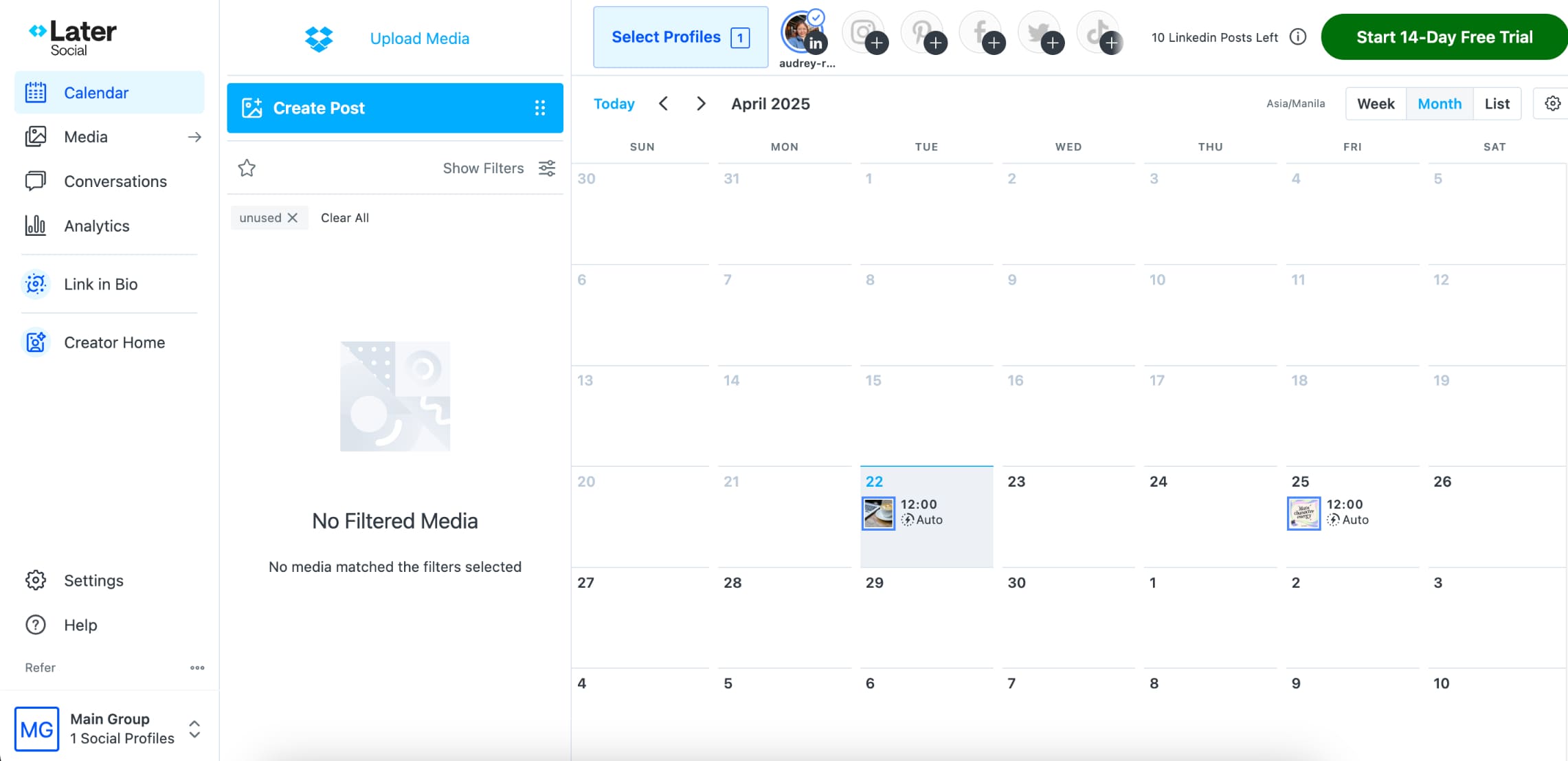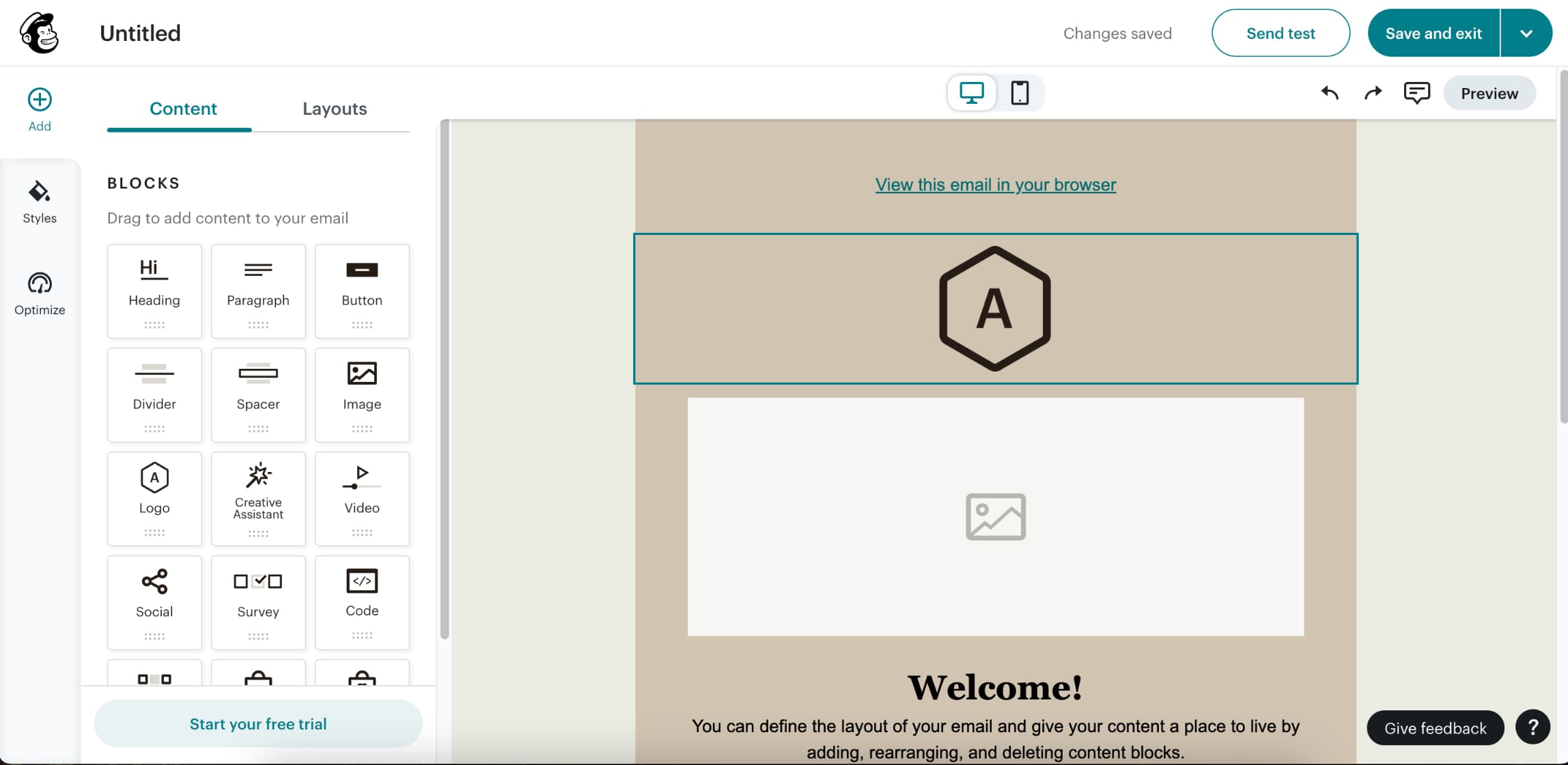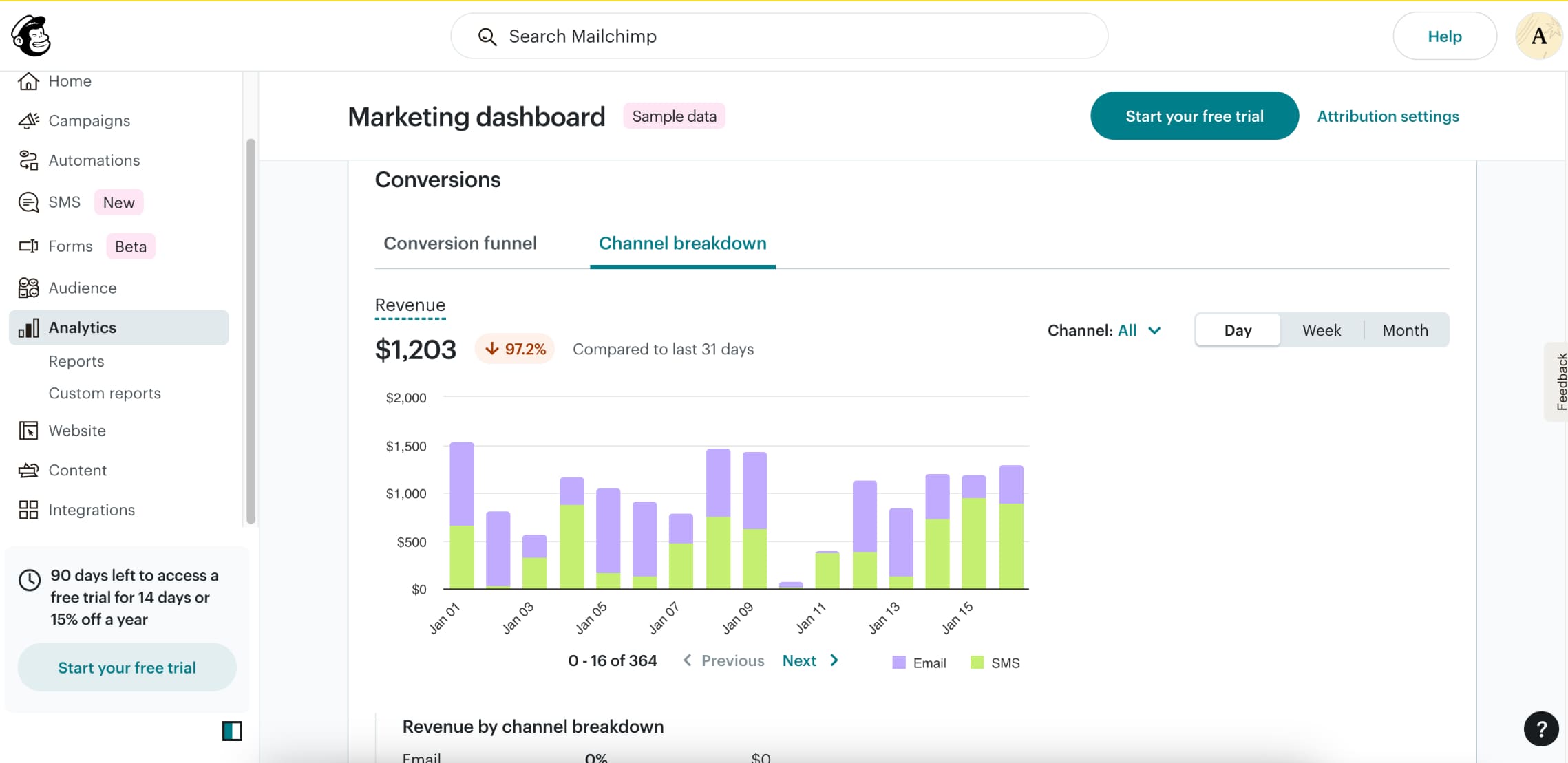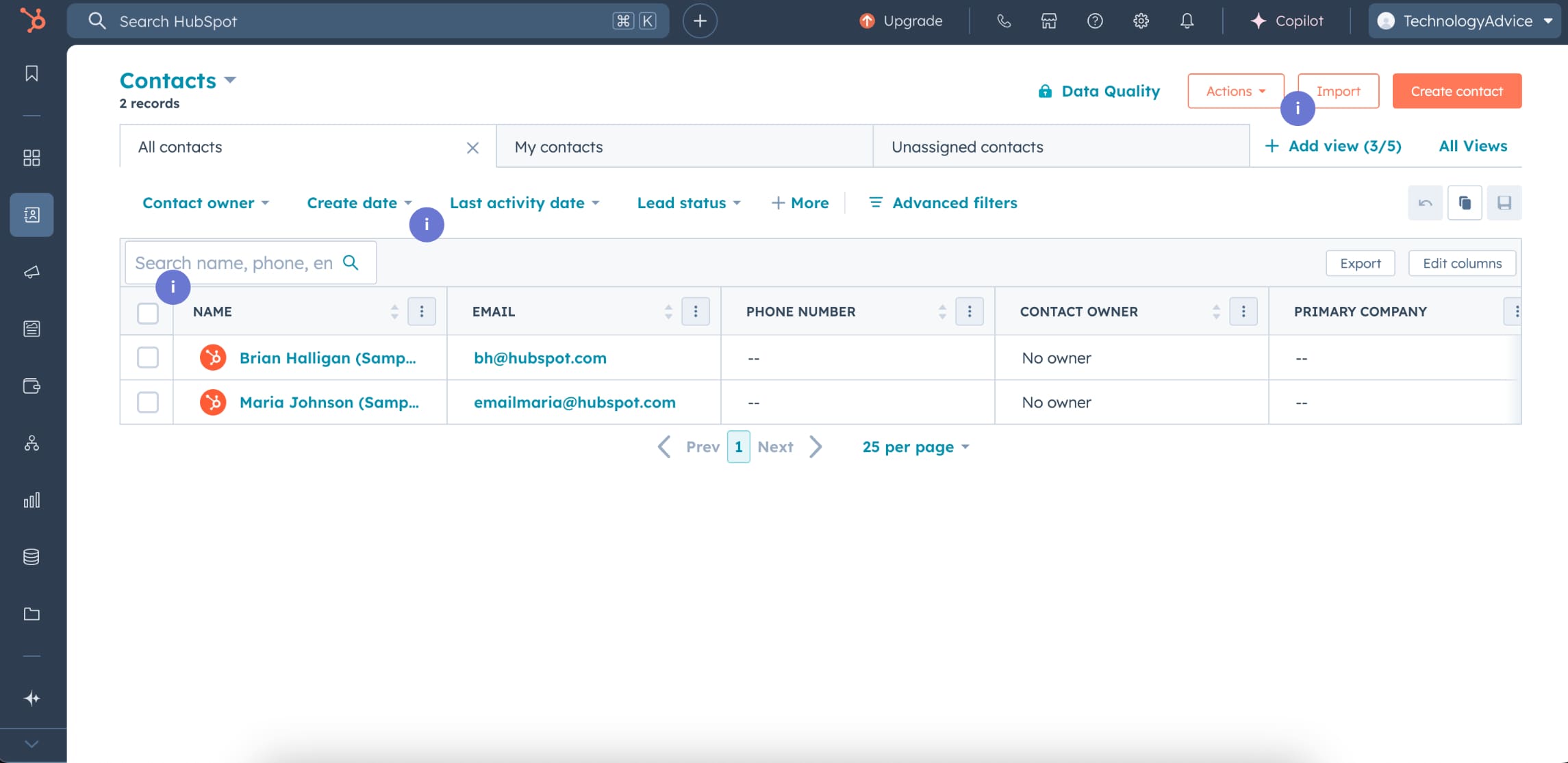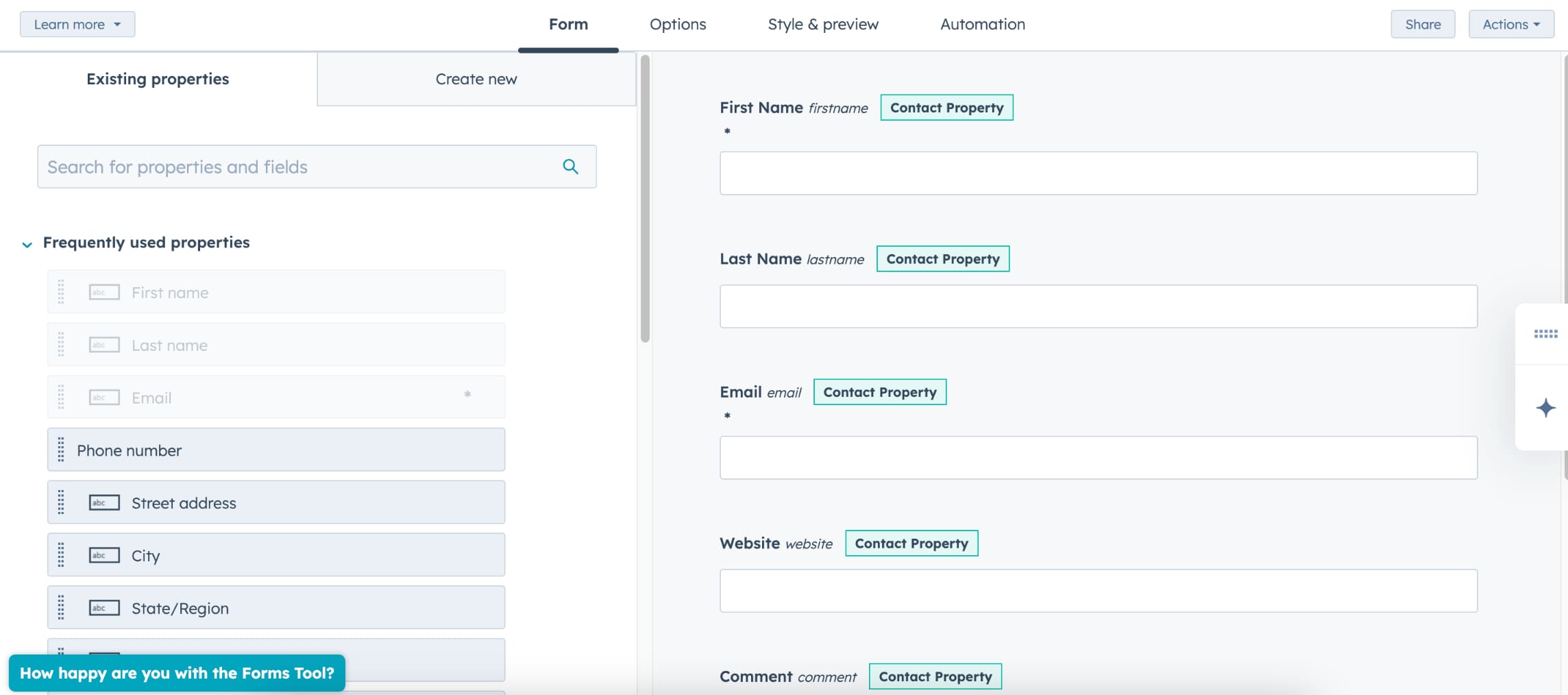A martech stack (aka a marketing technology stack) is just a fancy term for all the tools and software you use to promote your business. It’s like your marketing toolbox. A martech stack example might include a platform for email marketing, one for social media scheduling, and one more for managing leads.
The best marketing technology stack will differ for every small business. It’ll depend on your business’s unique needs, priorities, and marketing strategy. But in my years of marketing for startups and small businesses, I’ve used a good many tools, and the following is my ultimate best marketing tech stack for small businesses.
- Google Workspace: Best for collaborating with teams
- Monday: Best for managing projects efficiently
- Later Social: Best for social media planning and scheduling
- Mailchimp: Best for engaging, multi-touch email campaigns
- HubSpot: Best for capturing and nurturing leads
- Wix: Best for building landing pages
- Semrush: Best for content planning and research
- WordPress: Best for blog content that builds brand awareness
- Canva: Best for designing content and brand assets
What should be in your marketing technology stack?
The marketing tools in your tech stack should generally cover the three major marketing strategies: publishing content, capturing and nurturing leads, and internal team collaboration. Under those, they should also be able to cover the more specific strategies, like social media marketing, SEO, lead generation, ad campaigns, and more.
- Lead generation and customer management tools: These let you create signup forms for newsletters, events, ebook downloads, or free trials and demos in exchange for customers’ information. They also let you track and manage the leads you receive.
For some businesses, like salons and fitness studios, booking or sign-up platforms might pull double duty in this area. The hair salon I go to uses Acuity Scheduling to book clients online. They use the same system to send me reminder emails about upcoming appointments, birthday messages, and promos, smaller facets of their email marketing strategy.
- Landing page builders: These tools build standalone webpages that audiences “land” on in a marketing campaign. For example, after clicking on a Facebook ad promoting a discount, audiences might land on a page with a discount code.
Meanwhile, a business wanting to invest in paid search ads might create identical landing pages targeting specific keywords.
- Email marketing platforms: These help you set up, create, execute, and measure email marketing campaigns, from product promotions to newsletters. Some also let you automate drip campaigns. Many tools I mention in this article can also pull double duty here.For example, my friend uses Wix for her website. Wix has some email functions, but my friend found she needed a higher monthly send count, more design tools, and better control over her contacts. So she uses Mailchimp to fill her email marketing needs.
- Social media scheduling and monitoring tools: These let you schedule posts across multiple platforms, build a content calendar, and monitor your social media metrics.
- Blog publishing platforms: These are especially necessary if you plan on publishing blogs regularly to build an online presence. They let you write and publish blogs for an online audience.
- SEO tools: SEO tools cover everything involved in planning and researching SEO keywords to help your content rank on Google. They help suggest keywords and plan content around them.
- Business email and productivity tools: These give you a proper domain name for your and your team’s email addresses (instead of a generic one like @gmail.com). They also allow you to collaborate with team members on projects and hold video meetings.
However, technology is evolving, and so are marketing tech tools. Today, you’ll also find marketing tech solutions for automating processes, personalizing customer experiences, and collaborating across remote teams.
Best marketing technology stack tools at a glance
Best for | Notable features | Free plan | Free plan limitations | Starting cost | |
|---|---|---|---|---|---|
Creating a professional email address and collaborating with teams | Real-time team collaboration on Google Docs, Sheets, and Slides | ✓ | No custom email domain for your team (i.e., @yourbusiness.com). | $7 | |
 | Managing projects efficiently | Automated project workflows | ✓ | No automated project workflows | $9 |
 | Social media planning and scheduling | Social media content planner, unified message inbox | ✓ | Can only schedule posts on one social media platform | $16.67 |
Email campaigns to keep audiences engaged | Drag-and-drop email builder, automated email campaigns | ✓ | No email campaign scheduling | $13 | |
Capturing and nurturing leads into customers | Lead nurturing workflows, lead capture forms | ✓ | No automated lead workflows | $15 | |
 | Building landing pages for marketing campaigns | AI and drag-and-drop landing page builder | ✓ | No custom domain for landing pages | $17 |
Planning and researching content | Keyword researcher and analysis | ✓ | Can only monitor one website | $117.33 | |
 | Building brand awareness through blogging and content marketing | Content management system, blog publisher | ✓ | No custom domain for blog sites | $4 |
 | Designing content and brand assets | Brand kit, over 1 million design elements | ✓ | Limited design and template library | $15 |
Google Workspace: Best for collaborating with teams

Why I recommend it:
- Easy to use, reliable, and takes about 10 minutes to set up.
- The only business email platform (so far) with real-time collaboration on documents. You can collaborate on projects with teammates in real time.
- It’s entirely cloud-based, so documents save automatically.
What’s not great about it:
- Its email tools are mostly basic, with no advanced email automations beyond scheduled emails, for example.
- Storage can fill up pretty easily, especially if you’re only on the Business Start plan. You only get up to 30GB for email and cloud storage.
Features: An email platform, an email address with a custom domain for you and your team, cloud-based documents, presentations, and spreadsheets, video conferencing, and real-time collaboration
No platform defines business email and productivity like Google Workspace (except perhaps, some would argue, Microsoft 365). But it’s long been our top business email provider for small businesses because it offers all the productivity essentials: documents, spreadsheets, presentation decks, and video conferencing — all while being super easy to set up and use.
Google Workspace is also entirely cloud-based, so it’s ideal for remote teams or if you’re always on the go. Plus, one thing I’ve always found especially helpful is Google Workspace’s auto-saving feature that saves all your documents to the cloud as you work so that nothing ever gets lost. Also, if you already have a free Gmail account, upgrading to more efficient tools to run your business is easy.
If your team is starting to grow and you’re looking to upgrade to a more efficient collaboration platform, Google Workspace is the best choice.
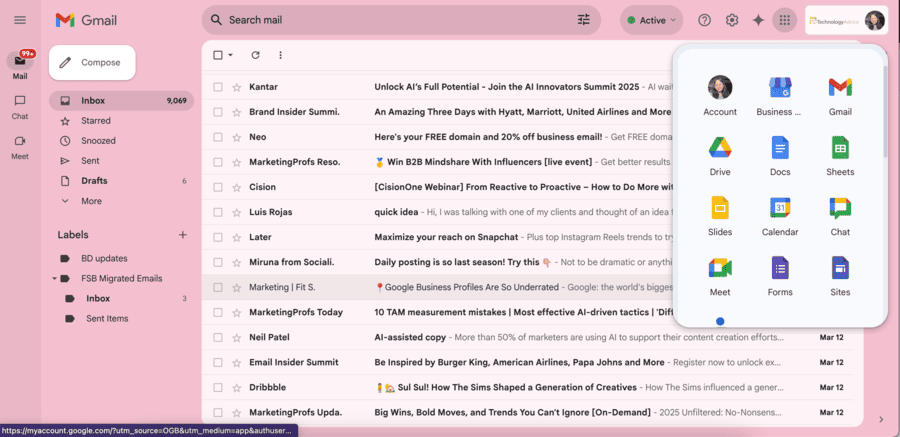
Google Workspace gives you a business email platform and easy real-time collaboration. (Source: Google Workspace)
Business Starter | Business Standard | Business Plus | |
|---|---|---|---|
Monthly cost | $7 | $14 | $22 |
Email address with a custom domain | ✓ | ✓ | ✓ |
Shared documents, spreadsheets, presentations, etc. | ✓ | ✓ | ✓ |
Real-time collaboration | ✓ | ✓ | ✓ |
Cloud storage | 30GB | 2TB | 5TB |
Video conferencing | 100 participants | 150 participants | 500 participants |
Monday: Best for managing projects efficiently

Why I recommend it:
- Gives an at-a-glance view of all your projects for the month, year, or custom time frame.
- Automation makes projects flow seamlessly by automatically notifying team members of project updates.
- Monday’s project management platform is customizable to your business’s exact needs.
What’s not great about it:
- There are limits on the number of custom automations you can build.
- Glitches happen on the platform from time to time, and sometimes all you can do is wait them out.
- Building custom boards and automation workflows takes time and effort and isn’t always seamless.
Features: Automated project workflows, customizable project management boards
The main benefit of Monday is its workflow automations that automatically move tasks to different teams’ boards once you update them to a certain status. This is especially helpful if you’re working with a large team (or even multiple teams).
You can also customize Monday’s automation settings to your team’s needs. For example, at Fit Small Business, we use Monday to organize our content workflows, and once they’re marked “Ready to Upload” in the status column, they’re automatically moved to the website team’s board.
What makes Monday different from other project management tools like Asana and Clickup is that it gives you an overview of all your tasks on your board and their statuses, which you can customize to your particular needs.
On the negative side, with Monday, all your boards are interconnected, sometimes making it difficult to work on your own tasks without accidentally moving something on someone else’s board. In a sense, everything you work on must belong on a board, or it simply doesn’t exist.
Monday gives each user a “My Work” board for items assigned to or by them. But after using Monday for nearly a year, I have yet to use this space. In my experience, the more complex your team’s boards, processes, and automation workflows are, the less helpful “My Work” is. Instead, I built a personal dashboard that uses widgets to keep me organized (but even that required significant set-up time).
Overall, Monday’s priority levels for each task, progress bars, and customizable views for each user mean everyone can work how they like. It’ll make a good addition to your tech stack once you have a larger team and need a tool to organize your marketing processes and workflows.
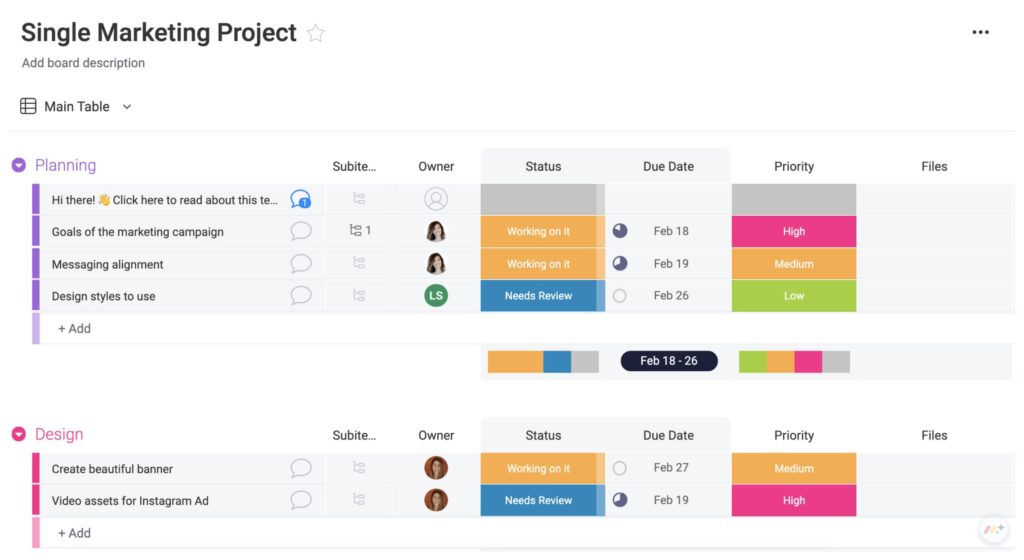
Monday lets you organize projects across teams. (Source: Monday)
Free | Basic | Standard | Pro | |
|---|---|---|---|---|
Monthly cost | $0 | $9 | $12 | $19 |
Tasks or items | 1,000 | Unlimited | Unlimited | Unlimited |
Storage | 500MB | 5 | 20 | 100GB |
Boards | 3 | Unlimited | Unlimited | Unlimited |
Documents | Unlimited | Unlimited | Unlimited | Unlimited |
Board templates | ✓ | ✓ | ✓ | ✓ |
Automated workflows | ✕ | ✕ | 250/month | 250,000/month |
Activity log | 1 week | 1 week | 6 months | 1 year |
Later Social: Best for social media planning and scheduling

Why I recommend it:
- It combines content calendar planning and social media scheduling. There’s no need for two separate platforms.
- It’s super easy to set up and navigate, even for beginners to social media marketing.
- It’s suitable for small businesses, influencers, and creators.
What’s not great about it:
- The free plan can only manage one social media platform. You’ll need a paid plan to manage multiple platforms.
- The social media inbox only supports Instagram and TikTok, so it won’t eliminate the need to work in those platforms directly.
- Social listening or comment monitoring is only available on the Enterprise plan.
Features: A social media content calendar, automatic scheduled posting across multiple platforms, a message inbox, post analytics, social listening, a link-in-bio site builder, influencer management platform, and creator community
Later Social marries social media scheduling with content planning, which is why it’s my top pick if you’re only adding one social media scheduler to your marketing technology stack. Its best feature by far is its content calendar that lets you plan social content weeks ahead and see everything at a glance — a lifesaver for any social media manager (and much easier to use than Meta Business Suite).
Aside from scheduling social content, there’s also a unified inbox so you can respond to messages and comments from the platform just as easily. However, this is only available for TikTok and Instagram messages, which is the biggest drawback compared to platforms like Sprout Social and Hootsuite.
However, Later Social continuously adds new features to adapt to social media trends. For instance, it has a link-in-bio mini site builder, an influencer management platform, and a creator community, all of which are relevant.
Free | Starter | Growth | Advanced | Agency | |
|---|---|---|---|---|---|
Monthly cost (annual billing) | $0 | $16.67 | $30 | $53.33 | $133.33 |
Social media profiles | 1 | 1 | 3 | 6 | 15 |
Multi-platform post scheduling | ✕ | ✓ | ✓ | ✓ | ✓ |
Scheduled posts per month | 12 | 30 | 150 | Unlimited | Unlimited |
TikTok and Instagram messages inbox | ✕ | ✕ | ✓ | ✓ | ✓ |
Link-in-bio creator | ✓ | ✓ | ✓ | ✓ | ✓ |
Social media analytics | 3 months | 3 months | 1 year | 1 year | 1 year |
Mailchimp: Best for engaging, multi-touch email campaigns

Why I recommend it:
- Mailchimp is easy to set up and navigate, and has all the necessary tools to build professional email campaigns.
- It offers small-business-friendly plans. The free plan includes 500 emails per day, and prices increase as your contact list grows.
- It’s one of the most reliable email platforms I’ve used. It also has a built-in audience platform that shows your recipients’ information and activity.
What’s not great about it:
- Using Mailchimp’s templates can make your emails look generic and unmemorable.
- While there’s a free plan, you can’t schedule emails on it — scheduling is only available on paid plans.
Features: An email campaign builder and scheduler, an audience management platform, campaign sign-up forms, email analytics (clicks, opens, and conversions), and a creative assistant for building branded emails
I’ve tried many email marketing platforms, but my main constant has always been Mailchimp. It’s one of the first platforms I tried when I started email marketing, and it’s still the most reliable one I recommend to most small businesses who want a simple, no-fuss email marketing platform to send mass marketing emails to multiple contacts or segmented lists (instead of one by one like Gmail).
Mailchimp has a free plan that can send up to 500 emails a day to the same number of contacts, which is just enough to start building an engaged email audience. It’s also easy to create email campaigns with the drag-and-drop builder, and you can easily use dozens of templates for professional-looking emails.
Mailchimp also lets you build automated email campaigns, say for cart abandonment or new client welcome emails. What I also like about Mailchimp is that it makes all these tasks easy. Even beginners can build professional, customer-ready email campaigns, see their results, and optimize future messages.
Free | Essentials | Standard | Premium | |
|---|---|---|---|---|
Monthly cost (annual billing) | $0 | $13 | $20 | $250 |
Email sends | 1,000/month or 500/day | 10x contacts | 12x contacts | 15x contacts |
Contacts | 500 | |||
Audience sets | 1 | 3 | 5 | Unlimited |
Analytics | Basic | Basic | Advanced | Advanced |
A/B testing | ✕ | ✓ | ✓ | ✓ |
Advanced segmentation and behavioral targeting | ✕ | ✕ | ✓ | ✓ |
HubSpot: Best for capturing and nurturing leads

Why I recommend it:
- Hubspot offers many tools in one platform, including lead capture forms and a contact management tool, for free.
- Forms you build using HubSpot can be easily shared on your website, online store page, or social media profile.
- HubSpot also has automation workflows for nurturing leads, including sending trigger-based marketing emails.
What’s not great about it:
- The lead-nurturing workflows are only available on paid plans from $15 per month.
- Having so many tools (and constant updates) sometimes makes HubSpot difficult to navigate.
Features: A lead management platform, automated lead workflows, lead capture forms, and lead nurturing emails
Every good martech stack has a reliable platform for capturing and nurturing leads, aka people who are interested in your business or have heard about it but haven’t yet become customers.
HubSpot has long been one of the best martech companies in that regard. It works for almost any type of business and has an intuitive interface that shows all your leads along with their information and status.
Plus, HubSpot has lead workflows, which are significant time-savers if you have a small but agile team. These workflows can automatically send lead-nurturing emails and alert your team if a lead performs an action like opening a link or completing a purchase.
It’s especially helpful if you have a large volume of leads and don’t have the time to build and send email campaigns to them all. Plus, HubSpot can send more personalized emails to each prospect based on their past behavior.
HubSpot also has tools for building lead capture forms to place on your website or social media pages, all in one platform. What makes it different from regular landing page builders like Wix is it automatically sends leads to the built-in HubSpot CRM platform along with their information and behavior. While it may take some exploring to get the hang of it, it’s one of the best AI-powered marketing tools to add to your stack.
Free | Starter Customer Platform | Professional Customer Platform | Enterprise Customer Platform | |
|---|---|---|---|---|
Monthly cost (annual billing) | $0 | $15 | $1,300 | $4,700 |
Contact management platform | ✓ | ✓ | ✓ | ✓ |
Lead capture forms | ✓ | ✓ | ✓ | ✓ |
Contacts | 1,000 | 1,000 | 2,000 | 10,000 |
Email sends | 2,000/month | 5x contacts | 10x contacts | 20x contacts |
Automated lead workflows | ✕ | ✓ | ✓ | ✓ |
Conversational chatbots | ✕ | ✓ | ✓ | ✓ |
Wix: Best for building landing pages

Why I recommend it:
- You can build as many landing pages as you want for free, from newsletter sign-up to app download pages.
- It’s intuitive and beginner-friendly — no coding necessary.
- It offers plenty of design freedom, so you can make your landing pages as unique, creative, and customized to your brand as you want.
What’s not great about it:
- Wix, unfortunately, does not build pop-up messages (although it can build non-indexed landing pages).
- You can build unlimited landing pages on the free plan, but they’ll all have a Wix subdomain (yoursite.wix.com).
Features: A drag-and-drop and AI website builder, over 50 landing page templates, plenty of design customization
Wix is my go-to website and landing page builder, whether I’m creating a landing page for a Facebook ad campaign or a creative portfolio. It’s always my first recommendation for small businesses and creators because the platform is easy and intuitive without sacrificing essential features or good design.
It’s also free to make as many landing pages as you want, which is handy if you plan to build many digital marketing campaigns (or already do) but don’t want your landing pages indexed with your main website.
For example, let’s say you use WordPress for your main website. You can use Wix to build landing pages for your Google Ads campaign, sign-up forms, or app download badge, on a domain that won’t be connected to your main website.
It can even build your one-page portfolio if you want to promote your services or previous work. Wix also allows complete design freedom, so each landing page can be as unique and customized as you need.
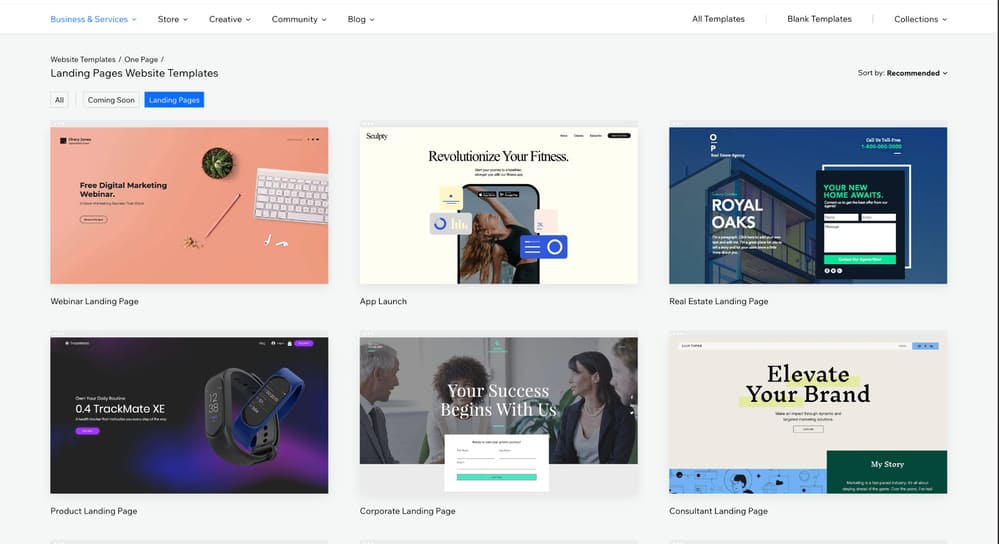
Wix is one of the most intuitive landing page builders, and it has many templates for various objectives and business types. (Source: Wix)
Free | Core | Business | Business Elite | |
|---|---|---|---|---|
Monthly cost (annual billing) | $0 | $17 | $29 | $36 |
Build unlimited landing pages | ✓ | ✓ | ✓ | ✓ |
Custom domain for your landing page | ✕ | ✓ | ✓ | ✓ |
Storage space | 500MB | 2GB | 50GB | 100GB |
Forms | 4 | 10 | 25 | 75 |
Accept payments | ✕ | ✕ | ✓ | ✓ |
Semrush: Best for content planning and research

Why I recommend it:
- Semrush is the most comprehensive SEO tool covering keyword research, website audits, and more.
- It’s free forever to monitor one website.
- It can also suggest the best content to publish on your blog based on your audience’s most-searched keywords.
What’s not great about it:
- There are no starter guides for the platform — you’ll need some basic SEO know-how.
- It doesn’t always account for Google’s algorithm changes, so its suggested keywords aren’t 100% accurate.
- The content marketing platform is only available on the $208 Guru plan.
Features: A keyword researcher and keyword recommendations, a website audit tool, website health analysis, and a content marketing planner
If you want to get your website ranking on Google, the best way is through an SEO content strategy, which is where Semrush can help. It has the most extensive suite of SEO tools, including a keyword researcher, website traffic checker, and even a blog content planner.
You’ll need some basic SEO know-how to get the most out of the platform, but compared to other SEO tools I’ve used, including Ahrefs and SimilarWeb, Semrush has been the most useful as it covers both the planning and analysis parts of SEO.
You can even subscribe to specific Semrush tools based on your content’s needs. For example, Semrush’s Keyword Magic Tool suggests hundreds of keyword combinations from one keyword, while the Traffic Analytics tool compares your website traffic with competitors.
If you’re only adding one SEO tool to your toolbox, this is the one I recommend. Semrush is used by many marketers worldwide (myself included) and is invaluable if you have a website and want it to be found by your target audience. It can help you navigate the best way for your website to be found online.
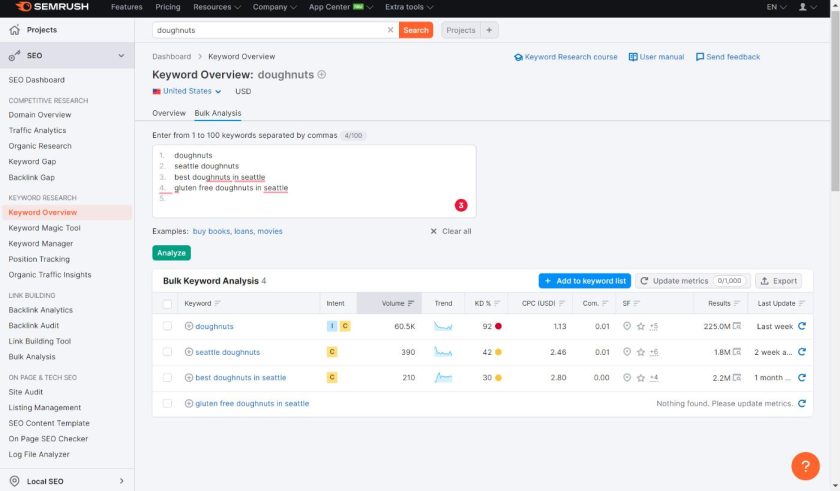
I’ve always found Semrush helpful in planning the best keywords to add to website content and analyzing competitors’ keywords. (Source: Semrush)
Free | Pro | Guru | Business | |
|---|---|---|---|---|
Monthly cost (annual billing) | $0 | $117.33 | $208.33 | $416.66 |
Tracked keywords | 10 | 500 | 1,500 | 5,000 |
Tracked websites | 1 | 5 | 15 | 40 |
Crawled website pages | 100 | 100,000 | 300,000 | 1 million |
Keyword research and competitor analysis | ✓ | ✓ | ✓ | ✓ |
Keyword clustering | ✕ | ✓ | ✓ | ✓ |
Content marketing platform | ✕ | ✕ | ✓ | ✓ |
WordPress: Best for blog content that builds brand awareness

Why I recommend it:
- Designed specifically for bloggers, its content management system is the industry standard.
- The free plan lets you publish unlimited blogs (although on a WordPress subdomain). Upgrading to a custom domain costs just $4 a month.
- SEO tools are native to the platform, including keywords, titles, descriptions, and custom slugs.
What’s not great about it:
- It requires building a website before you can publish blogs, which is not ideal if you already have a website for your business.
- SEO tools and analytics are only available on paid plans.
Features: A blog publisher, a content management system, blog keywords, and hundreds of blog templates
WordPress is still the industry leader for content websites and lets you publish unlimited blogs, even on the free plan. You can also customize your blog’s look and style to match your brand, or use one of WordPress’s blog templates, all of which have a variety of modern, eye-catching designs.
WordPress’s content management system also makes it easy to optimize your blog’s SEO through keywords, titles, and meta descriptions, which are necessary if you have a content marketing plan. You can also see all your blogs at a glance and how much traffic they get, allow comments and discussion forums, and even accept payments and donations.
WordPress will go hand-in-hand with Semrush if you use blogs to grow your brand credibility. Use Semrush to research your keywords and plan your blogs, then publish them on WordPress.
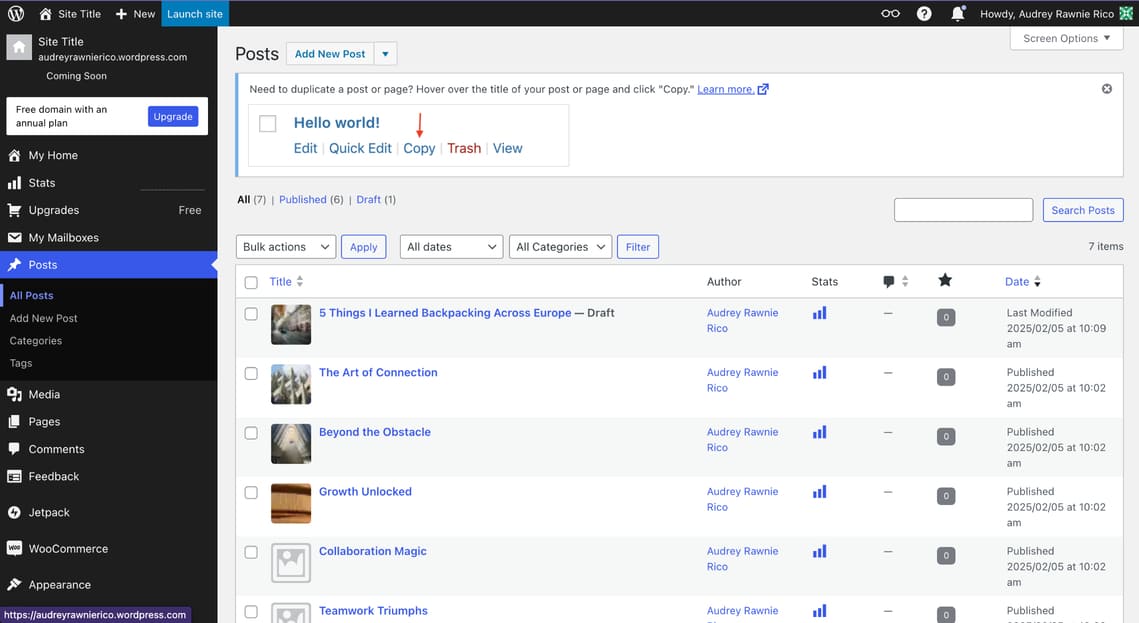
WordPress’s content management system is still the best in the industry and is ideal for publishing many blogs. (Source: WordPress)
Free | Personal | Premium | Business | Commerce | |
|---|---|---|---|---|---|
Monthly cost (annual billing) | $0 | $4 | $8 | $25 | $45 |
Publish unlimited blogs | ✓ | ✓ | ✓ | ✓ | ✓ |
Storage | 1GB | 6GB | 13GB | 50GB (Expandable) | 50GB (Expandable) |
Custom domain | ✕ | ✓ | ✓ | ✓ | ✓ |
Accept payments and donations | ✓ | ✓ | ✓ | ✓ | ✓ |
SEO tools and analytics | ✕ | ✕ | ✕ | ✓ | ✓ |
Canva: Best for designing content and brand assets

Why I recommend it:
- It’s an easy and (mostly) free way to design hundreds of marketing materials.
- The brand kit is super helpful for designing branded materials efficiently.
- There are templates for every marketing material imaginable, from presentation decks to infographics to email headers.
What’s not great about it:
- Canva’s designs can tend to be generic, and its better-designed templates are locked behind paid plans.
- Editing tools can be basic (no image editing or collage-making tools).
- Limited design freedom because you can only use the available tools and templates.
Features: An online drag-and-drop design platform, design templates for thousands of marketing materials, AI design generators and editors
Canva makes design easy and accessible to everyone, even if you don’t have design experience. There are thousands of templates for just about any design or marketing material you’ll need, from business cards to Instagram Stories.
The Brand Kit is invaluable as it stores all your brand assets — logos, colors, fonts, and so on — to make it easier to design branded materials in the future. One notable drawback with Canva is that, because many other people also use it, there’s a chance your designs won’t be entirely unique. I recommend taking the extra time to customize your designs to make them stand out.
Others on my team have reported experiencing a lot of difficulty editing videos for social and even static designs on the mobile app. The video editor isn’t very intuitive (especially when you’re overlaying text), and many of the best design elements are locked behind paid plans. Overall, it’s very easy to move something out of place when selecting small elements, making for a lot of zooming in and out.
Still, Canva’s an invaluable resource in your tech stack. It’s a simple and efficient way to create well-designed content. I just highly recommend using it on your laptop for bigger projects.
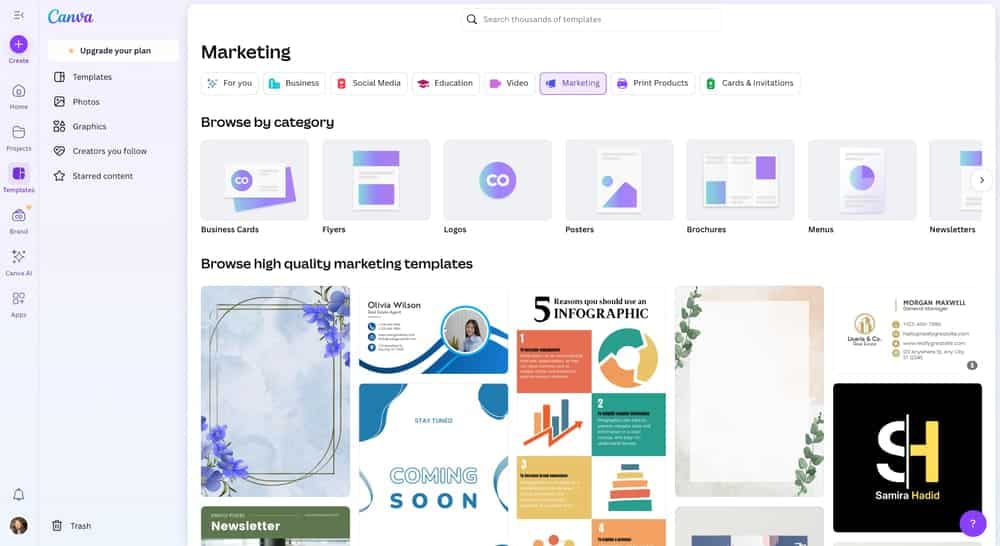
Canva has templates for almost every material you can think of. (Source: Canva)
Free | Personal | Premium | |
|---|---|---|---|
Monthly cost | $0 | $15 for one user | $10 per user (3 users minimum) |
Drag-and-drop design platform | ✓ | ✓ | ✓ |
Storage | 5GB | 1TB | 1TB |
Design templates | Limited access | Full access | Full access |
Design elements | ✓ | ✓ | ✓ |
Brand kit | ✕ | ✓ | ✓ |
Remove image backgrounds | ✕ | ✓ | ✓ |
Schedule social media posts | ✕ | ✓ | ✓ |
Collaborate with teams | ✕ | ✕ | ✓ |
Design approvals | ✕ | ✕ | ✓ |
How to build your marketing technology stack
I like to think of marketing tech stacks as slices of a pie with all the major marketing strategies, like email, blogging, etc. However, your stack will look different based on your marketing plan and objectives.
For instance, if your strategy focuses primarily on social media marketing to attract new customers, your martech stack might include Later Social and Canva. You might also need HubSpot to keep track of your leads.
Every business usually needs at least one tech tool from each major “slice” of the pie. It all comes down to your needs.
- Identify your primary objective. I want to generate new local leads for my neighborhood cafe from Google and social media.
- Strategize how you’ll achieve those objectives. I’ll publish localized content on my website for Google based on the best keywords for my cafe, then repurpose it into content for Facebook and Instagram.
- Set a budget, then choose the best tools to support your goals. My overall marketing tech budget is $100 per month. To find the best keywords to target for my blogs, I’ll use Semrush (free). I’ll use WordPress to start a blog and buy a custom domain ($4 to $10, depending on domain costs). To repurpose my blogs into Facebook and Instagram posts, I’ll use Canva Pro ($15) and Later Social ($16.67). Finally, I’ll also use HubSpot’s free version to track all my new leads (free).
Martech stack examples
As mentioned, your specific marketing technology stack will depend on your small business’s priorities. If you own a small local cafe, your marketing stack might focus primarily on local SEO and social media marketing technology tools.
But if you want to promote your brand-new tech startup, you may require a website and blogging platform to build your brand authority. Take a look at some marketing tech stack examples.
Example A: Marketing tech stack for a small local cafe
If I were marketing a small local neighborhood cafe, my main strategies would be building my cafe’s local SEO presence and making my business visible on social media. Therefore, my tech stack would focus on SEO keyword research tools and creating and scheduling social media posts.
Martech stack | Objective | Starting cost |
|---|---|---|
Semrush Free | Local keyword research | $0 |
Canva Pro | Creating social media graphics | $15 |
Later Social | Scheduling social media posts | $16.67 |
Total cost | $31.67/month | |
Example B: Marketing tech stack for a tech startup
If I were introducing a new tech startup, my marketing tech stack would look different because my strategies are more complex. Because I’d be introducing something completely new to the market, I would focus on building credibility through blog posts and generating leads through demos. So my tech stack would focus on WordPress, Semrush, and HubSpot.
Martech stack | Objective | Starting cost |
|---|---|---|
WordPress Personal | Publishing blogs | $4 |
Semrush Guru | Researching keywords for blogs and planning content | $208.33 |
HubSpot Starter | Collecting and managing leads | $15 |
Total cost | $227.33/month | |
How I chose the best marketing technology stack for small businesses (my evaluation criteria)
While the best marketing technology stack will differ for every business, I compiled the best of the best from my experience as a marketer and my evaluation of all the platforms listed in this guide. I also considered each platform’s value for money, marketing usefulness, and ease of use.
- Value for money: Different platforms have different plans and prices, so I made sure all of them offered good value for your money and let you access essential features on the free or starter plans.
- Marketing usefulness: All the platforms in this guide can help market your business, whether through maximizing your team’s productivity, creating and publishing content, or capturing and managing leads. Many of them are also used by many marketing teams around the world.
- Ease of use: Your team won’t have all the time in the world to learn how to use tech platforms, so I specifically looked for beginner-friendly tools that won’t be a pain to set up.
- My expert opinion: I’ve also personally used or at least tested all the platforms above to prove they can live up to their claims and effectively support small business marketing teams.
Frequently asked questions (FAQs)
Marketing technology stacks (aka martech stacks) are all the tech tools and platforms in your “toolbox” that help promote your business. For instance, you might have a platform for email marketing, one for blogging, one for designing content, and one for internal project management. A marketing tech example might include Google Workspace for communication and collaboration, Later Social for social media scheduling, and Mailchimp for email marketing.
Technology used for marketing usually includes tools for business email and productivity, project management, social media marketing, email marketing, leads management, SEO and content, and creative design. Other technology can include landing pages and automation builders, and AI writing assistants.
A marketing data stack includes marketing tech platforms that focus specifically on information, like customer data, ad audience data, or website traffic data. For example, a marketing data stack might include Google Analytics for website traffic, HubSpot for lead and customer information, and Semrush for keyword analysis.
Bottom line
A marketing technology stack is the arsenal of all the tools and platforms that will help market your business and attract new customers. The marketing stack you build will depend on your business’s unique marketing objectives and strategy. But it usually includes tools for managing projects, collaborating with teams, capturing and nurturing leads, and creating and publishing content.
To build your martech stack, decide on your primary marketing objectives, build a strategy around those objectives, and then choose the best tools to support your strategy.
